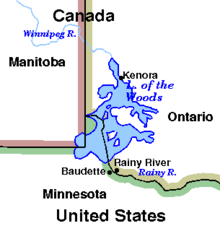| Lake of the Woods | |
|---|---|
| Lac des Bois Pikwedina Sagainan | |
 Lake of the Woods from space, September 2018 | |
| Location | North America |
| Coordinates | 49°14′59″N 94°45′03″W / 49.24972°N 94.75083°W |
| Lake type | Glacial |
| Primary inflows | |
| Primary outflows | Winnipeg River |
| Basin countries | Canada and United States |
| Max. length | 68 mi (109 km) |
| Max. width | 59 mi (95 km) |
| Surface area | 4,350 km2 (1,679.5 sq mi)[1] |
| Max. depth | 210 ft (64 m) |
| Shore length1 |
|
| Surface elevation | 323 m (1,060 ft)[1][2] |
| Islands | 14,632[1] |
| Settlements |
|
| 1 Shore length is not a well-defined measure. | |
Lake of the Woods (French: Lac des Bois; Ojibwe: Pikwedina Sagainan [3], lit. '"inland lake of the sand hills"') is a lake occupying parts of the Canadian provinces of Ontario and Manitoba and the U.S. state of Minnesota.[4] Lake of the Woods is over 70 miles (110 km) long and wide, containing more than 14,552 islands and 65,000 miles (105,000 km) of shoreline. It is fed by the Rainy River, Shoal Lake, Kakagi Lake and other smaller rivers. The lake drains into the Winnipeg River and then into Lake Winnipeg. Ultimately, its outflow goes north through the Nelson River to Hudson Bay.

Lake of the Woods is also the sixth largest freshwater lake located (at least partially) in the United States, after the five Great Lakes, and the 36th largest lake in the world by area. It separates a small land area of Minnesota from the rest of the United States. The Northwest Angle and the town of Angle Township can be reached from the rest of Minnesota only by crossing the lake or by traveling through Canada. The Northwest Angle is the northernmost part of the contiguous United States. Its "northwesternmost point" served as a problematic landmark in treaties defining the international border.
The lake's islands provide nesting habitats for the piping plover and large numbers of American white pelicans and as recently as the early 20th century also provided calving habitat to boreal woodland caribou. There are also several hundred nesting pairs of bald eagles in this area.
Lake of the Woods, a translation of the original French name Lac des Bois, was so named from its wooded setting.[5] However, it may have been a mistranslation of the Anishinaabe name.
The earliest name we find the lake known by is that given by Verendrye in his journey in 1731. He says it was called Lake Minitic (Cree: ministik; Ojibwe: minitig) or Des Bois. (1) The former of these names, Minitic, seems to be Anishinaabe, and to mean "Islands in a River", probably referring to the many islands found in the northern half of the lake. The other name (2) Lac des Bois, or Lake of the Woods, seems to have been a mistranslation[6] of the Indian [sic] name (Anishinaabe) by which the Lake was known.[7]
One of the names currently used in Anishinaabe for this lake is Babiikwaawangaa-zaagaʼigan meaning "Lake with Uneven Sand" referring to the lake's sand dunes.[8]
- ^ a b c "Lake of the Woods". The Canadian Encyclopedia. Retrieved May 18, 2021.
- ^ U.S. Geological Survey Geographic Names Information System: Lake of the Woods
- ^ "Lake of the Woods". 22 November 2017.
- ^ Priddle, George B. "Lake of the Woods". World Book Online Reference Center. 2008. 12 January 2008 Archived 8 June 2011 at the Wayback Machine
- ^ Gannett, Henry (1905). The Origin of Certain Place Names in the United States. Government Printing Office. pp. 179.
- ^ While the Anishinaabe noun suffix -tig refers to rivers, the Anishinaabe noun suffix -aatig refers to trees and wood.
- ^ The Manitoba Historical Society - The Lake of the Woods: Its History, Geology, Mining and Manufacturing by George Bryce. MHS Transactions, Series 1, No. 49, Read 23 February 1897
- ^ Pedchenko, Svetlana "Weshki-ayaad"; Gambill, G.; Lippert, C. J. (2009). "Freelang Dictionary―Ojibwe module". Freelang. Retrieved August 4, 2019.

